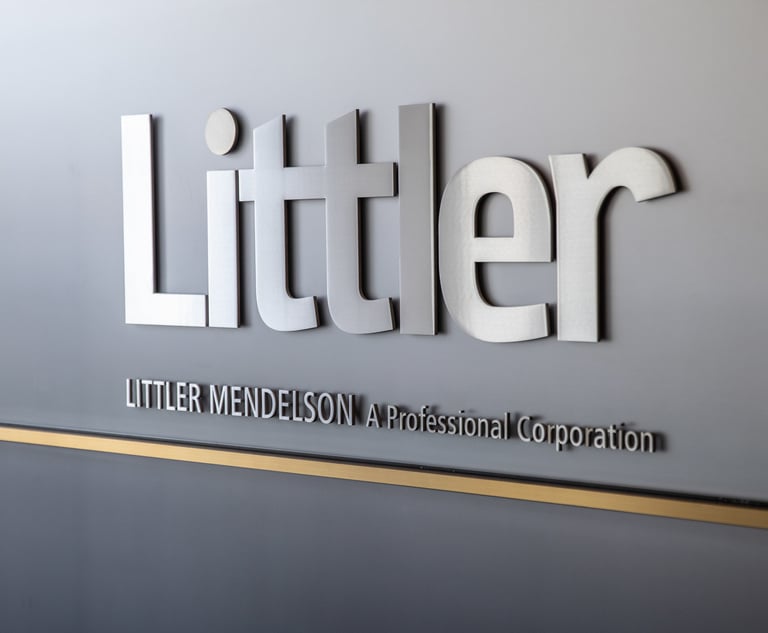As Clients Demand More Than Ever, How Can Lawyers and Firms Respond?
Clients are demanding more of outside counsel than ever before. An open dialogue can help both sides get what they need.
January 28, 2020 at 08:39 PM
8 minute read
 Credit: nchlsft/Shutterstock.com
Credit: nchlsft/Shutterstock.com
As the legal industry continues to disaggregate and is increasingly flooded with technology, clients and in-house counsel report that they want a more personalized legal relationship. As hyperpersonalization permeates the legal industry, clients will continue to push for more tailored service.
But it can be difficult for law firms to know where to begin when addressing these requests. Should they focus on data and analytics or knowledge management? Or maybe they should focus on security and risk awareness? What about staffing efficiencies and technology innovation? And what is a realistic investment in value-adds? For their part, in-house counsel tend to have a more difficult time obtaining or sharing necessary information; they also suffer from tangible constraints on time and resources that affect their practice and what they are able to commit to outside counsel partnership efforts.
These circumstances suggest that a key step in bridging the gap between client expectations and law firm efforts is for both sides to open a dialogue about needs and obstacles and how to develop collaborative ways to address them. Below, we discuss a few specific areas to consider as a starting place for those initial conversations, and for making the investment in better understanding clients' specific business and legal needs.
The Value of Data
Clients always want to know what a matter will cost and its predicted outcomes. Lawyers are frequently loathe to put a precise cost on their services, citing particular facts, judges' peculiarities, transaction type and other reasons for why predicting actual cost is hard. Leveraging data and analytics is one way in which firms can accede to client requests for more predictable pricing, staffing and results. Metrics about prior matters and their variables can also provide clients with more information about anticipated turnaround time, settlement value, jury verdicts and other considerations, which, in turn, clients can use at the outset of an engagement to make decisions that align with their broader business goals and directives. Essentially, data allows for a more informed decision-making process.
In a broader sense, clients are increasingly looking for future-facing information about their legal risks so they can be proactive about business decisions and internal budgeting. As just one example, a firm's ability to identify a business unit or location as a major source of litigation risk or of government enforcement actions can provide a client with valuable insight into various business elements, such as workplace culture, gaps in corporate policies, and even overlooked regulatory factors. Whether or not clients have explicitly asked for this type of data, firms can differentiate themselves by using the tools and information they have to track their clients' matters and to provide actionable feedback. Young lawyers, in particular, can add value early on in their careers by investing time and effort in understanding how their firm's data analytic systems can provide personalized and meaningful insights.
At the same time, if in-house counsel want or expect this kind of valuable service from their outside counsel, they ought to consider how they can make the necessary information available. One challenge is that there is often not a central, holistic repository of data maintained either by in-house or outside counsel. Also, if clients use outside counsel on an ad hoc basis, there is much less information, not to mention incentive, for outside counsel to provide such additional, detailed value.
There are ways firms and clients can work together to address these challenges, however. For example, in-house counsel have indicated the difficulty of navigating legal technology by explaining that the technology solutions often solve only part of a problem or are too focused on technological capabilities and not on addressing existing problems. Outside counsel are well-positioned to help clients navigate their in-house use of legal technology. In turn, this effort may result in clients being able to provide more and better data to firms, which firms can then use to augment their services—including data and analytics on particular matters and broader trends. Notably, some firms are already starting to offer technology consulting as a value-add at no charge—a recognition of the price of doing business in today's market, given clients' shifting needs and expectations.
A New Staffing Model
Clients regularly express the wish that outside lawyers would take the time to truly understand their business and its particular needs and concerns. This is in addition to other client demands—such as outside counsel guidelines—that can be difficult or expensive to comply with due to the complexity of requirements, lack of staff and technology to achieve compliance, or even attorneys' failure to actually read their clients' guidelines.
One way for firms to address these issues is to establish dedicated teams for particular clients and encourage those attorneys and staff to invest in a deeper understanding of the clients' business and requirements. Using a team-based staffing model can also help firms disaggregate tasks where appropriate, rather than leaving that work to clients. Instead of having a partner or associate manage all tasks, the team, with collaborative input from the client, may be better positioned to assess which tasks can be managed by paralegals, passed off to a consulting arm, or even outsourced to alternative (and more cost-effective) service providers. Firms that proactively partner with clients on these issues are likely to retain those clients, and even obtain more work from them, as opposed to those who ignore these issues.
Another method for expanding a firm's understanding of and relationship with a client is secondment. By placing lawyers or other staff members on site with clients, firms can develop that knowledge and improve the overall relationship while simultaneously providing real value to their clients. Many legal departments are consistently short-staffed, so even if general counsel have not asked for an embedded worker, their department may nevertheless have a genuine need for or interest in additional support. It is possible that they simply have not had the time to think about the need in any concrete way, much less to develop a comprehensive proposal for a secondment. Outside counsel can demonstrate an interest in better understanding a client's business by initiating the conversation about secondment options.
The purpose of secondments may depend on the nature of the client relationship. Secondments might be part and parcel of the firm's comprehensive, value-oriented relationship with certain institutional clients. In other instances, offering secondments may help a firm win more business from a client. There are also many clients that prohibit first-year associates from billing on their work. For these clients, outside counsel might propose a secondment program specifically for first-years, introducing them to key client contacts and the company's business before the client ever sees the young associate's name on a bill. A benefit of any secondment program is that it gives the firm insight into the client's day-to-day business needs and culture; seconded lawyers gain experience that serves them, the firm and the client long after the secondment period ends.
Incentives to Add Value
Rather than relying solely on client pressure to create attorney buy-in, firms should also consider internal policies and incentives to help their lawyers meet client demands for greater understanding of their business and proactive advice. This may mean awarding billable credit for contributing to initiatives and time spent actively collaborating with clients about their needs. It may also be something more simple, such as taking the time to educate firm lawyers about opportunities for change and the risks of complacency.
It is all too easy for both clients and outside counsel to sit back and expect the other party to present ideas for innovation and improved services. For law firms, waiting to change until a client asks for something new runs the risk of not seeing a problem until it is too late: the client never asks and instead moves the work elsewhere. At that point, it can be difficult to determine what, specifically, motivated the decision to shift work or part ways. Accordingly, firm leaders should feel empowered to initiate the process of improving the services they provide by inviting clients to share their wants and by encouraging their own lawyers to invest in collaborative efforts.
In turn, we encourage chief legal officers to engage in specific conversations about their expectations and the investments that their outside providers need to make, while being open to partnering and providing information as needed to make that happen. After the conversation has started, both firms and clients need to commit to keeping it going. Set times to follow up on the goals set and progress made toward achieving those goals. When these issues are approached from a collaborative, communicative starting point, both parties will benefit over the long run.
The views expressed here are personal to the authors and do not represent the opinions of their employers.
This content has been archived. It is available through our partners, LexisNexis® and Bloomberg Law.
To view this content, please continue to their sites.
Not a Lexis Subscriber?
Subscribe Now
Not a Bloomberg Law Subscriber?
Subscribe Now
NOT FOR REPRINT
© 2025 ALM Global, LLC, All Rights Reserved. Request academic re-use from www.copyright.com. All other uses, submit a request to [email protected]. For more information visit Asset & Logo Licensing.
You Might Like
View All

Three Akin Sports Lawyers Jump to Employment Firm Littler Mendelson

Brownstein Adds Former Interior Secretary, Offering 'Strategic Counsel' During New Trump Term
2 minute read
Trending Stories
- 1How ‘Bilateral Tapping’ Can Help with Stress and Anxiety
- 2How Law Firms Can Make Business Services a Performance Champion
- 3'Digital Mindset': Hogan Lovells' New Global Managing Partner for Digitalization
- 4Silk Road Founder Ross Ulbricht Has New York Sentence Pardoned by Trump
- 5Settlement Allows Spouses of U.S. Citizens to Reopen Removal Proceedings
Who Got The Work
J. Brugh Lower of Gibbons has entered an appearance for industrial equipment supplier Devco Corporation in a pending trademark infringement lawsuit. The suit, accusing the defendant of selling knock-off Graco products, was filed Dec. 18 in New Jersey District Court by Rivkin Radler on behalf of Graco Inc. and Graco Minnesota. The case, assigned to U.S. District Judge Zahid N. Quraishi, is 3:24-cv-11294, Graco Inc. et al v. Devco Corporation.
Who Got The Work
Rebecca Maller-Stein and Kent A. Yalowitz of Arnold & Porter Kaye Scholer have entered their appearances for Hanaco Venture Capital and its executives, Lior Prosor and David Frankel, in a pending securities lawsuit. The action, filed on Dec. 24 in New York Southern District Court by Zell, Aron & Co. on behalf of Goldeneye Advisors, accuses the defendants of negligently and fraudulently managing the plaintiff's $1 million investment. The case, assigned to U.S. District Judge Vernon S. Broderick, is 1:24-cv-09918, Goldeneye Advisors, LLC v. Hanaco Venture Capital, Ltd. et al.
Who Got The Work
Attorneys from A&O Shearman has stepped in as defense counsel for Toronto-Dominion Bank and other defendants in a pending securities class action. The suit, filed Dec. 11 in New York Southern District Court by Bleichmar Fonti & Auld, accuses the defendants of concealing the bank's 'pervasive' deficiencies in regards to its compliance with the Bank Secrecy Act and the quality of its anti-money laundering controls. The case, assigned to U.S. District Judge Arun Subramanian, is 1:24-cv-09445, Gonzalez v. The Toronto-Dominion Bank et al.
Who Got The Work
Crown Castle International, a Pennsylvania company providing shared communications infrastructure, has turned to Luke D. Wolf of Gordon Rees Scully Mansukhani to fend off a pending breach-of-contract lawsuit. The court action, filed Nov. 25 in Michigan Eastern District Court by Hooper Hathaway PC on behalf of The Town Residences LLC, accuses Crown Castle of failing to transfer approximately $30,000 in utility payments from T-Mobile in breach of a roof-top lease and assignment agreement. The case, assigned to U.S. District Judge Susan K. Declercq, is 2:24-cv-13131, The Town Residences LLC v. T-Mobile US, Inc. et al.
Who Got The Work
Wilfred P. Coronato and Daniel M. Schwartz of McCarter & English have stepped in as defense counsel to Electrolux Home Products Inc. in a pending product liability lawsuit. The court action, filed Nov. 26 in New York Eastern District Court by Poulos Lopiccolo PC and Nagel Rice LLP on behalf of David Stern, alleges that the defendant's refrigerators’ drawers and shelving repeatedly break and fall apart within months after purchase. The case, assigned to U.S. District Judge Joan M. Azrack, is 2:24-cv-08204, Stern v. Electrolux Home Products, Inc.
Featured Firms
Law Offices of Gary Martin Hays & Associates, P.C.
(470) 294-1674
Law Offices of Mark E. Salomone
(857) 444-6468
Smith & Hassler
(713) 739-1250









